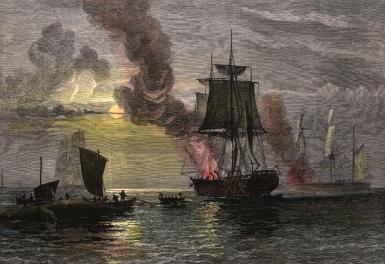| A Brief History of Whaling |
What Products Were Produced from Whales? |
Herman Melville | Was Moby Dick a Real Whale? |
What Products Were Made from Whales in the 1800s?
by Robert McNamara
 Whale ship boiling blubber in the South Seas. (Getty Images) |
We all know that men set forth in sailing ships and risked their lives to harpoon whales on the open seas throughout the 1800s. And while Moby Dick and other tales have made whaling stories immortal, people today generally don't appreciate that the whalers were part of a well-organized industry that turned the carcasses of whales into a great many useful and even fashionable items.
Oil from Whale’s Blubber
Oil was the main product sought from whales, and it was used to lubricate machinery and to provide illumination by burning it in lamps.
When a whale was killed, it was towed to the ship and its blubber, the thick insulating fat under its skin, would be peeled and cut from its carcass in a process known as “flensing.” The blubber was minced into chunks and boiled in large vats on board the whaling ship, producing oil.
The oil taken from whale blubber was packaged in casks and transported back to the whaling ship’s home port (such as New Bedford, Massachusetts, the busiest American whaling port in the mid-1800s).
From the ports it would be sold and transported across the country and would find its way into a huge variety of products.
Whale oil, in addition to be used for lubrication and illumination, was also used to manufacture soaps, paint, and varnish. Whale oil was also utilized in some processes used to manufacture textiles and rope.
Spermaceti, a Highly Regarded Oil
A peculiar oil found in the head of the sperm whale, spermaceti, was highly prized. The oil was waxy, and was commonly used in making candles. In fact, candles made of spermaceti were considered the best in the world, producing a bright clear flame without an excess of smoke.
Spermaceti was also used, distilled in liquid form, as an oil to fuel lamps. The main American whaling port, New Bedford, Massachusetts, was thus known as "The City That Lit the World."
When John Adams was the ambassador to Great Britain before serving as president he recorded in his diary a conversation about spermaceti he had with the British Prime Minister William Pitt. Adams, keen to promote the New England whaling industry, was trying to convince the British to import spermaceti sold by American whalers, which the British could use to fuel street lamps.
The British were not interested. In his diary, Adams wrote that he told Pitt, "the fat of the spermaceti whale gives the clearest and most beautiful flame of any substance that is known in nature, and we are surprised you prefer darkness, and consequent robberies, burglaries, and murders in your streets to receiving as a remittance our spermaceti oil."
Despite the failed sales pitch John Adams made in the late 1700s, the American whaling industry boomed in the early to mid-1800s. And spermaceti was a major component of that success.
Spermaceti could be refined into a lubricant that was ideal for precision machinery. The machine tools that made the growth of industry possible in the United States were lubricated, and essentially made possible, by oil derived from spermaceti.
Baleen, or "Whalebone"
The bones and teeth of various species of whales were used in a number of products, many of them common implements in a 19th century household. Whales are said to have produced “the plastic of the 1800s.”
The "bone" of the whale which was most commonly used wasn’t technically a bone, it was baleen, a hard material arrayed in large plates, like gigantic combs, in the mouths of some species of whales. The purpose of the baleen is to act as a sieve, catching tiny organisms in sea water, which the whale consumes as food.
As baleen was tough yet flexible, it could be used in a number of practical applications. And it became commonly known as "whalebone".
Perhaps the most common use of whalebone was in the manufacture of corsets, which fashionable ladies in the 1800s wore to compress their waistlines. One typical corset advertisement from the 1800s proudly proclaims, "Real Whalebone Only Used."
Whalebone was also used for collar stays, buggy whips, and toys. Its flexibility even caused it to be used as the springs in early typewriters.
The comparison to plastic is apt. Think of common items which today might be made of plastic, and it's likely that similar items in the 1800s would have been made of whalebone.
Baleen whales do not have teeth. But the teeth of other whales, such as the sperm whale, would be used as ivory in such products as chess pieces, piano keys, or the handles of walking sticks. And, while scrimshaw is probably the best remembered use of whale's teeth, the intricate carvings were generally done by sailors to pass the time on whaling voyages and were not a mass production industry.
Related
- Why Whaling Was So Important in the 19th Century
- Herman Melville, Moby Dick's Frustrated Author
- The White Whale That Spooked Sailors and Inspired Herman Mellvile